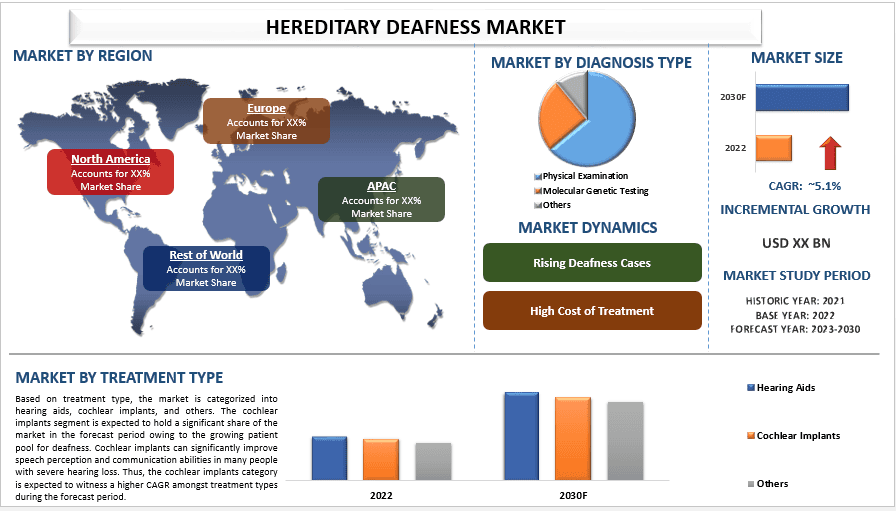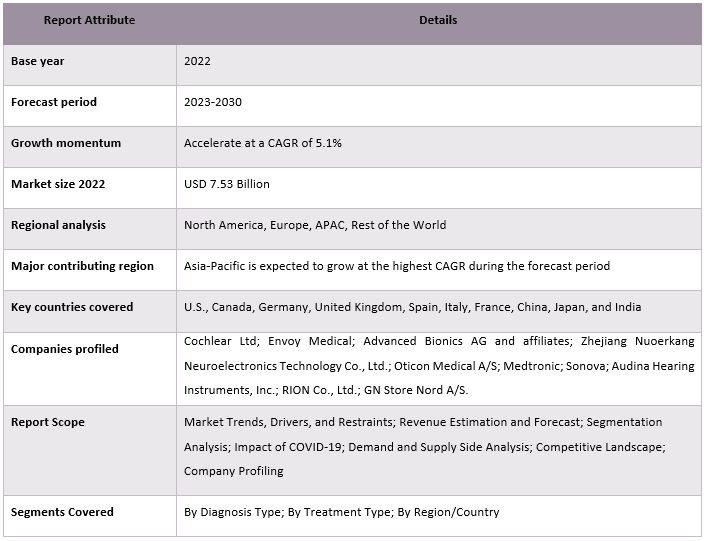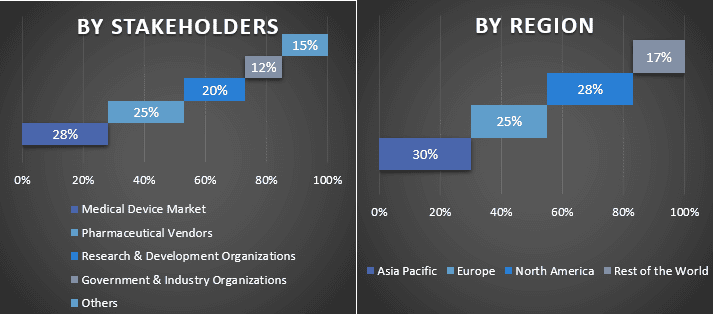
유전성 난청 시장은 2022년에 75억 3천만 달러로 평가되었으며 예측 기간(2023~2030년) 동안 연평균 성장률(CAGR) 5.1%로 성장할 것으로 예상됩니다. 유전성 난청은 특히 소음 노출이나 노화와 같은 환경적 요인이나 후천적 요인이 아닌 유전적 요인에 의해 발생하는 청력 손실을 의미합니다. 청력 손실에 대한 인식이 높아짐에 따라 조기 발견과 유전성 난청의 유전적 원인을 식별하기 위한 유전자 검사가 강조됩니다. 이는 유전성 난청으로 진단받고 적절한 치료 옵션을 찾는 사람이 더 많아지게 할 수 있습니다. 유전성 난청은 주로 난청 치료법 개발을 위한 혁신이 증가함에 따라 시장에서 두각을 나타냈습니다. 예를 들어, 2024년 1월, 일반의약품 보청기 분야의 선두 주자인 Lexie Hearing은 강화된 앱 내 청력 테스트 기능과 새로운 충전용 휴대 케이스, 최대 18시간 충전으로 배터리 수명을 연장하는 Bose 기반 Lexie B2 Plus 자가 맞춤 OTC 보청기를 출시했습니다. 이 외에도 이비인후과 부서에 대한 투자와 유전성 난청에 대한 정부 인식 프로그램이 최근 몇 년 동안 크게 증가했으며, 이는 시장에 기회를 창출하는 주요 요인입니다.
Cochlear Ltd, Envoy Medical, Advanced Bionics AG 및 계열사, Zhejiang Nuoerkang Neuroelectronics Technology Co., Ltd., Oticon Medical A/S, Medtronic, Sonova, Audina Hearing Instruments, Inc., RION Co., Ltd., GN Store Nord A/S는 시장의 주요 업체 중 일부입니다. 이러한 업체들은 고객에게 첨단 혁신적인 제품/기술을 제공하기 위해 여러 M&A와 파트너십을 체결했습니다.
보고서에 제시된 인사이트
"진단 유형 중 분자 유전자 검사 범주가 예측 기간 동안 더 높은 CAGR을 기록할 것입니다."
진단 유형에 따라 시장은 신체 검사, 분자 유전자 검사 및 기타로 분류됩니다. 분자 유전자 검사 부문은 유전자 검사 기술의 발전으로 인해 예측 기간 동안 높은 CAGR로 성장할 것으로 예상됩니다. 분자 유전자 검사는 특히 유전적 요인이 더 널리 퍼져 있는 조기 발병 또는 심각한 난청 환자에게 높은 진단 수율을 제공합니다. 확정적인 유전자 진단은 귀중한 예후 정보를 제공하고, 치료 결정을 내리고, 가족 검사를 용이하게 하고, 생식 상담에 정보를 제공할 수 있습니다. 따라서 진단 유형 중 분자 유전자 검사 부문은 예측 기간 동안 더 높은 CAGR을 기록할 것으로 예상됩니다.
"치료 유형 중, 보청기가 2022년에 시장에서 상당한 점유율을 차지했습니다."
치료 유형에 따라 시장은 보청기, 인공 와우 및 기타로 분류됩니다. 보청기 부문은 전 세계적으로 보청기의 기술 발전이 증가함에 따라 시장을 지배하고 있습니다. 예를 들어, 2024년 2월에 Oticon은 보청기 사용자의 청취 의도를 이해하고 그에 따라 대응할 수 있는 사용자 의도 센서가 장착된 세계 최초의 보청기인 새로운 보청기 Oticon Intent를 출시했습니다. 보청기는 청력 손실이 있는 사람들을 위해 소리를 증폭하는 귀 안이나 뒤에 착용하는 작은 전자 장치입니다. 주변의 소리를 포착하고 사용자의 청력 프로필에 따라 특정 주파수를 증폭하도록 처리한 다음 스피커를 통해 증폭된 소리를 귀에 전달하는 방식으로 작동합니다. 따라서 보청기는 2022년에 유전성 난청 시장에서 상당한 점유율을 차지했습니다.
"지역 중, APAC이 예측 기간 동안 더 높은 CAGR을 기록할 것으로 예상됩니다."
APAC은 예측 기간 동안 전 세계 유전성 난청 시장에서 높은 CAGR로 성장할 것으로 예상됩니다. 다양한 보청기 도입 증가, 향상된 접근성 및 다양한 의료 비용과 같은 여러 요인이 예측 기간 동안 시장 성장을 주도하고 있습니다. 또한 유전성 난청 발생률 증가는 시장 성장에 긍정적인 영향을 미치고 있습니다. 이 지역에서는 유전성 난청과 제품 출시에 대한 주요 인식 프로그램이 있었습니다. 예를 들어, 2024년 2월에 미국에 본사를 둔 청각 기술 분야의 글로벌 리더인 Starkey는 인도에서 혁신적인 Genesis AI 보청기를 출시했습니다. 따라서 APAC은 예측 기간 동안 더 높은 CAGR을 기록할 것으로 예상됩니다.

이 보고서를 구매해야 하는 이유:
- 이 연구에는 인증된 주요 업계 전문가가 검증한 시장 규모 측정 및 예측 분석이 포함되어 있습니다.
- 이 보고서는 전체 업계 성과에 대한 간략한 개요를 한눈에 제공합니다.
- 이 보고서는 주요 비즈니스 재무, 제품 포트폴리오, 확장 전략 및 최근 개발에 중점을 두고 저명한 업계 동료에 대한 심층 분석을 다룹니다.
- 업계에서 널리 퍼져 있는 동인, 제약, 주요 동향 및 기회에 대한 자세한 조사.
- 이 연구는 다양한 부문에 걸쳐 시장을 포괄적으로 다룹니다.
- 업계에 대한 심층적인 지역 수준 분석.
맞춤 설정 옵션:
글로벌 유전성 난청 시장은 요구 사항 또는 기타 시장 부문에 따라 추가로 맞춤 설정할 수 있습니다. 이 외에도 UMI는 귀하가 고유한 비즈니스 요구 사항을 가질 수 있음을 이해하므로 귀하의 요구 사항에 완전히 적합한 보고서를 얻으려면 언제든지 저희에게 연락하십시오.
목차
유전성 난청 시장 분석 (2023-2030)을 위한 연구 방법론
글로벌 유전성 난청 시장의 과거 시장 분석, 현재 시장 규모 추정 및 미래 시장 예측은 주요 지역에서 유전성 난청의 채택을 생성하고 분석하기 위해 수행된 세 가지 주요 단계였습니다. 과거 시장 수치를 수집하고 현재 시장 규모를 추정하기 위해 철저한 2차 연구가 수행되었습니다. 둘째, 이러한 통찰력을 검증하기 위해 수많은 조사 결과 및 가정이 고려되었습니다. 또한 글로벌 유전성 난청 시장의 가치 사슬 전반에 걸쳐 업계 전문가들과 심층적인 1차 인터뷰도 진행되었습니다. 1차 인터뷰를 통해 시장 수치를 가정하고 검증한 후, 전체 시장 규모를 예측하기 위해 하향식/상향식 접근 방식을 사용했습니다. 그 후, 산업의 세분 시장 및 하위 세분 시장의 시장 규모를 추정하고 분석하기 위해 시장 세분화 및 데이터 삼각 측량 방법을 채택했습니다. 자세한 방법론은 아래에 설명되어 있습니다.
과거 시장 규모 분석
1단계: 2차 자료 심층 연구:
연례 보고서 및 재무 제표, 실적 발표, 보도 자료 등과 같은 회사 내부 자료와 저널, 뉴스 및 기사, 정부 간행물, 경쟁사 간행물, 부문 보고서, 제3자 데이터베이스 및 기타 신뢰할 수 있는 간행물을 포함한 외부 자료를 통해 유전성 난청 시장의 과거 시장 규모를 확보하기 위해 자세한 2차 연구가 수행되었습니다.
2단계: 시장 세분화:
유전성 난청 시장의 과거 시장 규모를 확보한 후, 주요 지역의 다양한 세분 시장 및 하위 세분 시장에 대한 과거 시장 통찰력과 점유율을 수집하기 위해 자세한 2차 분석을 수행했습니다. 주요 세분 시장은 보고서에 진단 유형, 치료 유형 및 지역으로 포함됩니다. 해당 지역의 테스트 모델의 전체 채택을 평가하기 위해 추가적인 국가 수준 분석이 수행되었습니다.
3단계: 요인 분석:
다양한 세분 시장 및 하위 세분 시장의 과거 시장 규모를 획득한 후, 유전성 난청 시장의 현재 시장 규모를 추정하기 위해 자세한 요인 분석을 수행했습니다. 또한 유전성 난청의 진단 유형, 치료 유형 및 지역과 같은 종속 및 독립 변수를 사용하여 요인 분석을 수행했습니다. 전 세계 유전성 난청 시장 부문에서 최고의 파트너십, 합병 및 인수, 사업 확장 및 제품 출시를 고려하여 수요 및 공급 측면 시나리오에 대한 철저한 분석이 수행되었습니다.
현재 시장 규모 추정 및 예측
현재 시장 규모 산정: 위의 3단계에서 얻은 실행 가능한 통찰력을 바탕으로 글로벌 유전성 난청 시장의 현재 시장 규모, 주요 업체 및 세분 시장의 시장 점유율을 파악했습니다. 필요한 모든 백분율 점유율 분할 및 시장 세분화는 위에서 언급한 2차 접근 방식을 사용하여 결정되었으며 1차 인터뷰를 통해 확인되었습니다.
추정 및 예측: 시장 추정 및 예측을 위해 이해 관계자가 사용할 수 있는 동인 및 추세, 제약 및 기회를 포함한 다양한 요인에 가중치가 부여되었습니다. 이러한 요인을 분석한 후 관련 예측 기법(즉, 하향식/상향식 접근 방식)을 적용하여 전 세계 주요 시장에서 다양한 세분 시장 및 하위 세분 시장에 대한 2030년 시장 예측에 도달했습니다. 시장 규모를 추정하기 위해 채택된 연구 방법론은 다음을 포함합니다.
- 수익(USD) 측면에서 업계의 시장 규모와 국내 주요 시장에서 유전성 난청 시장의 채택률
- 시장 세분 시장 및 하위 세분 시장의 모든 백분율 점유율, 분할 및 세분화
- 제공되는 제품 측면에서 글로벌 유전성 난청 시장의 주요 업체. 또한 빠르게 성장하는 시장에서 경쟁하기 위해 이러한 업체가 채택한 성장 전략
시장 규모 및 점유율 검증
1차 연구: 주요 지역 전반에 걸쳐 최고 경영진(CXO/VP, 영업 책임자, 마케팅 책임자, 운영 책임자, 지역 책임자, 국가 책임자 등)을 포함한 핵심 오피니언 리더(KOL)와 심층 인터뷰를 진행했습니다. 그런 다음 1차 연구 결과를 요약하고 통계 분석을 수행하여 명시된 가설을 입증했습니다. 1차 연구의 입력은 2차 결과와 통합되어 정보를 실행 가능한 통찰력으로 전환했습니다.
다양한 지역의 1차 참가자 분할

시장 엔지니어링
데이터 삼각 측량 기법을 사용하여 전체 시장 추정을 완료하고 글로벌 유전성 난청 시장의 각 세분 시장 및 하위 세분 시장에 대한 정확한 통계 수치를 얻었습니다. 글로벌 유전성 난청 시장에서 진단 유형, 치료 유형 및 지역 분야의 다양한 매개변수 및 추세를 연구한 후 데이터를 여러 세분 시장 및 하위 세분 시장으로 분할했습니다.
글로벌 프로테아좀 억제제 시장 연구의 주요 목표
글로벌 유전성 난청 시장의 현재 및 미래 시장 동향이 연구에서 정확히 지적되었습니다. 투자자는 연구에서 수행된 질적 및 양적 분석에 대한 재량에 따라 투자를 기반으로 전략적 통찰력을 얻을 수 있습니다. 현재 및 미래 시장 동향은 지역 수준에서 시장의 전반적인 매력을 결정하여 산업 참가자가 미개척 시장을 활용하여 선점자 이점을 활용할 수 있는 플랫폼을 제공합니다. 연구의 다른 양적 목표는 다음과 같습니다.
- 가치(USD) 측면에서 유전성 난청 시장의 현재 및 예측 시장 규모를 분석합니다. 또한 다양한 세분 시장 및 하위 세분 시장의 현재 및 예측 시장 규모를 분석합니다.
- 연구의 세분 시장에는 진단 유형, 치료 유형 및 지역 분야가 포함됩니다.
- 유전성 난청 산업에 대한 규제 프레임워크를 정의하고 분석합니다.
- 다양한 중개자의 존재와 관련된 가치 사슬을 분석하고 업계의 고객 및 경쟁자 행동을 분석합니다.
- 주요 지역에 대한 유전성 난청 시장의 현재 및 예측 시장 규모를 분석합니다.
- 보고서에서 연구된 지역의 주요 국가에는 아시아 태평양, 유럽, 북미 및 기타 세계가 포함됩니다.
- 빠르게 성장하는 시장에서 지속하기 위해 시장 참여자가 채택한 유전성 난청 시장 및 성장 전략의 회사 프로필.
- 업계에 대한 심층적인 지역 수준 분석.
자주 묻는 질문 자주 묻는 질문
Q1: 유전성 난청 시장의 현재 시장 규모와 성장 잠재력은 무엇입니까?
Q2: 유전성 난청 시장 성장의 주요 요인은 무엇입니까?
Q3: 진단 유형별 유전성 난청 시장에서 가장 큰 점유율을 차지하는 부문은 무엇입니까?
Q4: 유전성 난청 시장의 새로운 기술과 트렌드는 무엇입니까?
Q5: 어느 지역이 유전성 난청 시장을 지배할 것인가?
Q6: 유전성 난청 시장에서 활동하는 주요 기업은 어디인가요?
관련 보고서
이 상품을 구매한 고객님들도 함께 구매하신 상품










